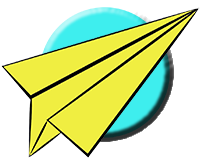Redwood Paper Airplane Folding Instructions
Redwood Paper Airplane Folding Instructions
Instructions
1. Fold the paper exactly in half about its short edge.
2. Fold the top-most layer of the paper down so the upper left and right points hit the bottom edge of the paper.
3. Fold the top-most flap created by the previous fold back over on top of itself so the bottom edge of the paper comes to the center.
4. Unfold all of the flaps created previously so the paper is completely open and flat on the working surface.
5. Fold the upper left and right points down so the top edge of the paper lines up with the existing crease which is closest to the bottom edge of the paper.
6. Fold the upper left and right points down so the top edge of the paper lines up with the crease which is closest to the bottom edge of the paper.
7. Again, fold the upper left and right points down so the edge of the paper lines up with the crease which is closest to the bottom edge of the paper.
8. Unfold all of the previous folds so the paper is completely open and flat on the working surface.
9. Fold the paper in half about the existing crease which is forth from the bottom edge of the paper. Note that not all the creases you have on your sheet are shown here.
10. Fold the upper edge of the paper about the existing crease which is first from the right edge of the paper.
11. Fold the right edge of the paper over about the existing crease which is third from the right edge of the paper. When folded correclty, the right edge should line up with the existing crease which is first from the left edge of the paper.
12. Rotate the paper around so the flaps are towards the top.
13. Fold the upper left corner down so the upper left point hits the existing crease which is second from the top edge of the paper. Unfold after the crease has been made.
14. Switch to the right side of the paper.
15. Fold the upper right corner down so the upper right point hits the existing crease which is second from the top edge of the paper. Unfold after the crease has been made.
16. Unfold the top-most layer of paper.
17. Pop the center points of the triangular sections up and in toward the middle while bringing the top edge of the paper over and down. When folded correctly, the triangular sections should tuck under the top-most layer.
18. Fold the top-most layer back about the existing crease which is first form the top edge of the paper. Bring the left and right points of the top layer in towards the middle so they hit the bottom edge of the middle layer. Two new creases are created as the fold is pressed flat.
19. Bring the two inside points from the top-most layer up and over so they hit the existing crease which is first from the top edge of the paper. Bring the outside points, forming two new creases as the fold is pressed flat.
20. Fold the middle flap back and over on top of itself about the existing crease.
21. Fold the tip of the nose down about the existing crease.
22. Fold the first several layers of paper back about the existing crease.
23. Flip the paper over so the previously created flaps are underneath.
24. Fold the left point over and in towards the middle. The lower point of the crease should be at the bottom left corner of the paper and the upper point should be at the upper left corner of the nose.
25. Switch to the right side. Fold the right point over and in towards the middle. The lower point of the crease should be at the bottom right corner of the paper and the upper point should be at the upper right corner of the nose.
26. Fold the top edge of the paper down about the existing crease which is first from the top edge of the paper.
27. Flip the plane over and rotate it around so the nose is to the left.
28. Fold the plane exactly in half about its short edge. Be sure to line up the sides for good balance.
29. Rotate the plane around so the nose is to the right.
30. Make a crease for the first wing flap. The right point of the crease should be about one finger width up from the bottom edge of the fuselage and the left point should be about two finger widths up.
31. Flip the plane over so the first wing flap is underneath the nose points to the left.
32. Make a crease for the second wing flap. Be sure to line up the wing flaps for good balance and flying characteristics.
33. Open up the wing flaps and adjust the wing angles so they are even. Set the dihedral angle flat or slightly up.
THE THROW Launch with a moderate throw at a slight up angle. The Redwood with its blunt heavy nose can be thrown hard for acrobatics if well trimmed and symmetric. A gentle launch from a high place will also produce a long glide.
